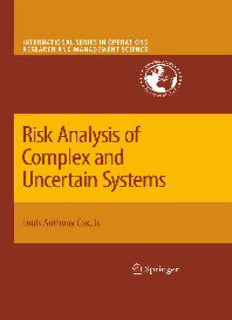Table Of ContentRisk Analysis of Complex and Uncertain Systems
INT.SERIESINOPERATIONSRESEARCH&MANAGEMENTSCIENCE
SeriesEditor:FrederickS.Hillier,StanfordUniversity
SpecialEditorialConsultant:CamilleC.Price,StephenF.AustinStateUniversity
Titleswithanasterisk(∗)wererecommendedbyDr.Price
Axsa¨ter/INVENTORYCONTROL,2ndEd.
Hall/PATIENTFLOW:ReducingDelayinHealthcareDelivery
Jo´zefowska&We˛glarz/PERSPECTIVESINMODERNPROJECTSCHEDULING
Tian&Zhang/VACATIONQUEUEINGMODELS:TheoryandApplications
Yan,Yin&Zhang/STOCHASTICPROCESSES,OPTIMIZATION,ANDCONTROLTHEORY
APPLICATIONSINFINANCIALENGINEERING,QUEUEINGNETWORKS,AND
MANUFACTURINGSYSTEMS
Saaty&Vargas/DECISIONMAKINGWITHTHEANALYTICNETWORKPROCESS:Economic,
Political,Social&TechnologicalApplicationswithBenefits,Opportunities,Costs&Risks
Yu/TECHNOLOGYPORTFOLIOPLANNINGANDMANAGEMENT:PracticalConceptsandTools
Kandiller/PRINCIPLESOFMATHEMATICSINOPERATIONSRESEARCH
Lee&Lee/BUILDINGSUPPLYCHAINEXCELLENCEINEMERGINGECONOMIES
Weintraub/MANAGEMENTOFNATURALRESOURCES:AHandbookofOperationsResearch
Models,Algorithms,andImplementations
Hooker/INTEGRATEDMETHODSFOROPTIMIZATION
Dawandeetal./THROUGHPUTOPTIMIZATIONINROBOTICCELLS
Friesz/NETWORKSCIENCE,NONLINEARSCIENCE,andINFRASTRUCTURESYSTEMS
Cai,Sha&Wong/TIME-VARYINGNETWORKOPTIMIZATION
Mamon&Elliott/HIDDENMARKOVMODELSINFINANCE
delCastillo/PROCESSOPTIMIZATION:AStatisticalApproach
Jo´zefowska/JUST-IN-TIMESCHEDULING:Models&AlgorithmsforComputer&Manufacturing
Systems
Yu,Wang&Lai/FOREIGN-EXCHANGE-RATEFORECASTINGWITHARTIFICIALNEURAL
NETWORKS
Beyeretal./MARKOVIANDEMANDINVENTORYMODELS
Shi&Olafsson/NESTEDPARTITIONSOPTIMIZATION:MethodologyandApplications
Samaniego/SYSTEMSIGNATURESANDTHEIRAPPLICATIONSINENGINEERINGRELIABILITY
Kleijnen/DESIGNANDANALYSISOFSIMULATIONEXPERIMENTS
Førsund/HYDROPOWERECONOMICS
Kogan&Tapiero/SUPPLYCHAINGAMES:OperationsManagementandRiskValuation
Vanderbei/LINEARPROGRAMMING:Foundations&Extensions,3rdEdition
Chhajed&Lowe/BUILDINGINTUITION:InsightsfromBasicOperationsMgmt.Modelsand
Principles
Luenberger&Ye/LINEARANDNONLINEARPROGRAMMING,3rdEdition
Drewetal./COMPUTATIONALPROBABILITY:AlgorithmsandApplicationsintheMathematical
Sciences∗
Chinneck/FEASIBILITYANDINFEASIBILITYINOPTIMIZATION:AlgorithmsandComputation
Methods
Tang,Teo&Wei/SUPPLYCHAINANALYSIS:AHandbookontheInteractionofInformation,
System,andOptimization
Ozcan/HEALTHCAREBENCHMARKINGANDPERFORMANCEEVALUATION:AnAssessment
UsingDataEnvelopmentAnalysis(DEA)
Wierenga/HANDBOOKOFMARKETINGDECISIONMODELS
Agrawal&Smith/RETAILSUPPLYCHAINMANAGEMENT:QuantitativeModelsandEmpirical
Studies
∼Alistoftheearlypublicationsintheseriesisfoundattheendofthebook∼
Louis Anthony Cox, Jr.
Risk Analysis of Complex
and Uncertain Systems
123
LouisAnthonyCox,Jr.
CoxAssociates
503FranklinStreet
DenverCO80218
USA
[email protected]
ISBN978-0-387-89013-5 e-ISBN978-0-387-89014-2
DOI10.1007/978-0-387-89014-2
LibraryofCongressControlNumber:2008940639
(cid:2)c SpringerScience+BusinessMedia,LLC2009
Allrightsreserved.Thisworkmaynotbetranslatedorcopiedinwholeorinpartwithoutthewritten
permission of the publisher (Springer Science+Business Media, LLC, 233 Spring Street, New York,
NY10013,USA),exceptforbriefexcerptsinconnectionwithreviewsorscholarlyanalysis.Usein
connection with any form of information storage and retrieval, electronic adaptation, computer
software,orbysimilarordissimilarmethodologynowknownorhereafterdevelopedisforbidden.
The use in this publication of trade names, trademarks, service marks, and similar terms, even if
they are not identified as such, is not to be taken as an expression of opinion as to whether or not
theyaresubjecttoproprietaryrights.
Printedonacid-freepaper
springer.com
ToChristineandEmeline
Preface
WhyThisBook?
Thisbookismotivatedbythefollowingconvictions:
1) Quantitativeriskassessment(QRA)canbeapowerfuldisciplineforimproving
riskmanagementdecisionsandpolicies.
2) Poorly conducted QRAs can produce results and recommendations that are
worsethanuseless.
3) Sound riskassessmentmethods provide thebenefits ofQRAmodeling –being
able to predict and compare the probable consequences of alternative actions,
interventions, or policies and being able to identify those that make preferred
consequencesmoreprobable–whileavoidingthepitfalls.
ThisbookdevelopsandillustratesQRAmethodsforcomplexanduncertainbio-
logical,engineering,andsocialsystems.Thesesystemshavebehaviorsthataretoo
complexoruncertaintobemodeledaccuratelyindetailwithhighconfidence.Prac-
ticalapplicationsincludeassessingandmanagingrisksfromchemicalcarcinogens,
antibioticresistance,madcowdisease,terroristattacks,andaccidentalordeliberate
failuresintelecommunicationsnetworkinfrastructure.
ForWhomIsItMeant?
This book is intended primarily for practitioners who want to use rational quanti-
tativeriskanalysistosupportandimproveriskmanagementdecisionsinimportant
health, safety, environmental, reliability, and security applications, but who have
beenfrustratedintryingtoapplytraditionalquantitativemodelingmethodsbythe
highuncertaintyand/orcomplexityofthesystemsinvolved.Weemphasizemethods
andstrategiesformodelingcausalrelationsincomplexanduncertainsystemswell
enoughtomakeeffectiveriskmanagementdecisions.Thebookiswrittenforpracti-
tionersfrommultipledisciplines–decisionandriskanalysts,operationsresearchers
and management scientists, quantitative policy analysts, economists, health and
vii
viii Preface
safetyriskassessors,engineers,andmodelers–whoneedpracticalwaystopredict
andmanagerisksincomplexanduncertainsystems.
What’sinIt?
Three introductory chapters describe QRA and compare it to less formal alterna-
tives, such as taking prompt action to address current concerns, even if the con-
sequences caused by the recommended action are unknown (Chapter 1). These
chapters survey QRA methods for engineering risks (Chapter 2) and health risks
(Chapter3).Briefexamplesofapplicationssuchasfloodcontrol,softwarefailures,
chemicalreleases,andfoodsafetyillustratethescopeandcapabilitiesofQRAfor
complexanduncertainsystems.
Chapter 1 discusses a concept of concern-driven risk management, in which
qualitative expert judgments about whether concerns warrant specified risk man-
agementinterventionsareusedinpreferencetoQRAtoguideriskmanagementde-
cisions.WhereQRAemphasizestheformalquantitativeassessmentandcomparison
oftheprobableconsequencescausedbyrecommendedactionstotheprobablecon-
sequencesofalternatives,includingthestatusquo,concern-drivenriskmanagement
insteademphasizestheperceivedurgencyorseverityofthesituationmotivatingrec-
ommendedinterventions.Inmanyinstances,especiallythoseinvolvingapplications
of a “Precautionary Principle” (popular in much European legislation), no formal
quantification or comparison of probable consequences for alternative decisions is
seen as being necessary (or, perhaps, possible or desirable) before implementing
riskmanagementmeasuresthatareintendedtopreventseriousorirreversibleharm,
evenifthecausalrelationsbetweentherecommendedmeasuresandtheirprobable
consequences are unclear. Such concern-driven risk management has been recom-
mendedbycriticsofQRAinseveralareasofappliedriskmanagement.
Basedoncasestudiesandpsychologicalliteratureontheempiricalperformance
of judgment-based decision making under risk and uncertainty, we conclude that,
althoughconcern-drivenriskmanagementhasseveralimportantpotentialpolitical
and psychological advantages over QRA, it often performs less well than QRA in
identifyingriskmanagementinterventionsthatsuccessfullyprotecthumanhealthor
achieveotherdesiredconsequences.Therefore,thosewhoadvocatereplacingQRA
with concern-driven alternatives, such as expert judgment and consensus decision
processes, should assess whether their recommended alternatives truly outperform
QRA, by the criterion of producing preferred consequences, before rejecting the
QRAparadigmforpracticalapplications.
Chapter2introducesmethodsofprobabilisticriskassessment(PRA)forpredict-
ingandmanagingrisksincomplexengineeredsystems.ItsurveysmethodsforPRA
and decision making in engineered systems, emphasizing progress in methods for
dealingwithuncertainties,communicatingresultseffectively,andusingtheresults
toguideimproveddecisionmakingbymultipleparties.Forsystemsoperatingunder
threats from intelligent adversaries, novel methods and game-theoretic ideas can
Preface ix
helptoidentifyeffectiveriskreductionstrategiesandresourceallocations.Inhard
decision problems, where the best course of action is unclear and data are sparse,
ambiguous,orconflicting,state-of-the-artmethodologycanbecriticalforgoodrisk
management. This chapter discusses some of the most useful PRA methods and
possibleextensionsandimprovements.
Chapter 3 introduces methods of quantitative risk assessment (QRA) for pub-
lichealthrisks.Thesearisefromtheoperationofcomplexengineering,economic,
medical,andsocialsystems,rangingfromfoodsupplynetworkstoindustrialplants
toadministrationofschoolvaccinationprogramsandhospitalinfectioncontrolpro-
grams.Thedecisionsandbehaviorsofmultipleeconomicagents(e.g.,theproduc-
ers, distributors, retailers, and consumers of a product) or other decision makers
(e.g.,parents,physicians,andschoolsinvolvedinvaccinationprograms)affectrisks
that,inturn,typicallyaffectmanyotherpeople.Healthrisksarecommonlydifferent
fordifferentsubpopulations(e.g.,infants,theelderly,andtheimmunocompromised,
for a microbial hazard; or customers, employees, and neighbors of a production
process).Thus,publichealthriskanalysisoftenfallsintheintersectionofpolitics,
business,law,economics,ethics,science,andtechnology,withdifferentparticipants
andstakeholdersfavoringdifferentriskmanagementalternatives.Inthispoliticized
context,QRAseekstoclarifytheprobableconsequencesofdifferentriskmanage-
mentdecisions.
Chapters4and5(aswellasChapter15,whichdealsspecificallywithterrorism
risk assessment) emphasize that sound risk assessment requires developing sound
riskmodelsinenoughdetailtorepresentcorrectlythe(oftenprobabilistic)causalre-
lationsbetweenasystem’scontrollableinputsandtheoutputsorconsequencesthat
decision makers care about. “Sound” does not imply completely accurate, certain,
ordetailed.Imperfectandhigh-levelriskmodels,orsetsofalternativeriskmodels
that are contingent on explicitly stated assumptions, can still be sound and useful
for improving decision making. But a sound model must describe causal relations
correctly, even ifnot ingreat detail,and even ifcontingent on stated assumptions.
Incorrectcausalmodels,ormodelswithhiddenfalseassumptionsaboutcauseand
effect,canleadtopoorriskmanagementrecommendationsanddecisions.
Chapters 4 and 5 warn against popular shortcut methods of risk analysis that
try to avoid the work required to develop and validate sound risk models. These
includereplacingempiricallyestimatedandvalidatedcausalriskmodels(e.g.,sim-
ulation models) with much simpler ratings of risky prospects using terms such as
high,medium,andlowforattributessuchasthefrequencyandseverityofadverse
consequences.Othershortcutmethodsusehighlyaggregateriskmodelsorscoring
formulas(suchas“risk=potency×exposure,”or“risk=threat×vulnerability×
consequence”) in place of more detailed causal models. Many professional con-
sultants,riskassessors,andregulatoryagenciesusesuchmethodstoday.However,
theseattemptedshortcutsdonotworkwellingeneral.AsdiscussedinChapters4
and5,theycanproduceresults,recommendations,andprioritiesthatareworsethan
useless:theyareevenlesseffective,onaverage,thanmakingdecisionsrandomly!
Poorriskmanagementdecisions,basedonfalsepredictionsandassumptions,result
fromtheseshortcutmethods.
x Preface
Fortunately,itispossibletodomuchbetter.Buildingandvalidatingsoundcausal
riskmodelsleadstoQRAmodelsandanalysesthatcangreatlyimproveriskman-
agement decisions. Chapters 6 through 16 explain how. They introduce and illus-
trate techniques for testing causal hypotheses and for identifying potential causal
relationsfromdata(Chapters6and7),fordeveloping(andempiricallytestingand
validating)riskmodelstopredicttheresponsesofcomplex,uncertain,andnonlinear
systems to changes in controllable inputs (Chapters 8-13), and for making more
effectiveriskmanagementdecisions,despiteuncertaintiesandcomplexities(Chap-
ters14-16).Thesechaptersposeavarietyofimportantriskanalysischallengesfor
complexanduncertainsystems,andproposeandillustratemethodsforsolvingthem
inimportantreal-worldapplications.
Keychallenges,methodsandapplicationsinChapters6through16includethe
following:
(cid:2)
Information-theoryanddata-miningalgorithms.Chapter6showshowtodetect
initially unknown, possibly nonlinear (including u-shaped) causal relations in
epidemiological data sets, using food poisoning data as an example. A combi-
nation of information theory and nonparametric modeling methods (especially,
classification tree algorithms) provide constructive ways to identify potential
causal relations (including nonlinear and multivariate ones with high-order in-
(cid:2) teractions)inmultivariateepidemiologicaldatasets.
Testingcausalhypothesesanddiscoveringcausalrelations.Chapter7,building
onthemethodsinChapter6,discusseshowtotestcausalhypothesesusingdata,
how to discover new causal relations directly from data without any a priori
hypotheses, and how to use data mining and other statistical methods to avoid
imposingone’sownpriorbeliefsontheinterpretationofdata–aperennialchal-
lenge in risk assessment and other quantitative modeling disciplines. An appli-
(cid:2) cationtoantibiotic-resistantbacterialinfectionsillustratesthesetechniques.
Useofnew molecular-biological and “-omics” informationinriskassessment.
Chapter 8 shows how to use detailed biological data (arising from advances in
genomics,proteomics,metabolomics,andotherlow-levelbiologicaldata)topre-
dictthefractionofillnesses,diseases,orotherunwantedeffectsinapopulation
that could be prevented by removing specific hazards or sources of exposure.
Thischallengeisaddressedbyusingconditionalprobabilityformulasandcon-
servative upper bounds on the observed occurrence and co-occurrence rates of
events in a causal network to obtain useful upper bounds on unknown causal
fractions. Bounding calculations are illustrated by quantifying the preventable
fraction of smoking-associated lung cancers in smokers caused by – and pre-
ventable by blocking – a particular causal pathway (involving polycyclic aro-
matic hydrocarbons forming adducts with DNA in a critical tumor suppressor
(cid:2) gene)thathasattractedgreatrecentinterest.
Upper-boundingmethods.Chapters8through12considerhowtouseavailable
knowledge and information about causal pathways in complex systems, even
if very imperfect and incomplete (e.g., biomarker data for complex diseases),
to estimate upper bounds on the preventable fractions of disease that could be
Description:"Tony Cox is among the most active and creative architects and users of quantitative risk analysis. This book is full of interesting equations, conceptual designs and conundrums that characterize QRA and its applications to risk management. Informed by trenchant thinking and perceptive writing, this

